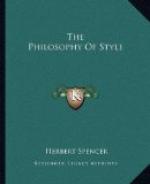35. The occasional increase of force produced by Metonymy may be similarly accounted for. “The low morality of the bar,” is a phrase both more brief and significant than the literal one it stands for. A belief in the ultimate supremacy of intelligence over brute force, is conveyed in a more concrete, and therefore more realizable form, if we substitute the pen and the sword for the two abstract terms. To say, “Beware of drinking!” is less effective than to say, “Beware of the bottle!” and is so, clearly because it calls up a less specific image.
36. The Simile is in many cases used chiefly with a view to ornament, but whenever it increases the force of a passage, it does so by being an economy. Here in an instance: “The illusion that great men and great events came oftener in early times than now, is partly due to historical perspective. As in a range of equidistant columns, the furthest off look the closest; so, the conspicuous objects of the past seem more thickly clustered the more remote they are.”
37. To construct by a process of literal explanation, the thought thus conveyed would take many sentences, and the first elements of the picture would become faint while the imagination was busy in adding the others. But by the help of a comparison all effort is saved; the picture is instantly realized, and its full effect produced.
38. Of the position of the Simile, it needs only to remark, that what has been said respecting the order of the adjective and substantive, predicate and subject, principal and subordinate propositions, &c., is applicable here. As whatever qualifies should precede whatever is qualified, force will generally be gained by placing the simile before the object to which it is applied. That this arrangement is the best, may be seen in the following passage from the ‘Lady of the Lake’;
“As wreath of snow,
on mountain breast,
Slides from the rock
that gave it rest,
Poor Ellen glided from
her stay,
And at the monarch’s
feet she lay.”
Inverting these couplets will be found to diminish the effect considerably. There are cases, however, even where the simile is a simple one, in which it may with advantage be placed last, as in these lines from Alexander Smith’s ‘Life Drama’:
“I see the future stretch
All dark and barren
as a rainy sea.”
The reason for this seems to be, that so abstract an idea as that attaching to the word “future,” does not present itself to the mind in any definite form, and hence the subsequent arrival at the simile entails no reconstruction of the thought.
39. Such, however, are not the only cases in which this order is the most forcible. As the advantage of putting the simile before the object depends on its being carried forward in the mind to assist in forming an image of the object, it must happen that if, from length or complexity, it cannot be so carried forward, the advantage is not gained. The annexed sonnet, by Coleridge, is defective from this cause:




